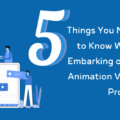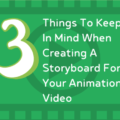You’ve dialed in your script, storyboarding and even animation. Now all that’s left is making decisions regarding the audio components to drive your message home. We say “all” like it’s a small thing, but audio is make or break when it comes to your animated video. It sets the tone, shapes expectations, and aligns your brand with certain markets and audiences. Here’s what to think about when choosing your voiceover talent and music.
Defining Your Music Selection
Music is key for evoking a certain mood in your audience. The type of music that’s ideal for your animated video will depend on the purpose and tone of your video – and also your overall brand. But in general:
- Informative video: use a light instrumental track with a slower, quieter beat.
- Advertising video: use an upbeat and motivating instrumental track or pop song (although beware of licensing fees)
Consider your audience when choosing your background and foreground music selections. Think about the demographics of your audience and their interests. Also be aware of how your music selection will work with or against your voiceover or animation – you generally don’t want anything too loud, disruptive, or distracting that takes away from your message rather than enhancing it. Typically, we recommend avoiding music with vocals, a driving beat, or prominent instrumental solos.
One thing to take note of is the cost of licensing well-known songs. These can be extremely expensive and may require you to pay royalties. Unless your budget allows for it, consider the many low-cost and royalty-free music options available instead.
A Voiceover Artist vs. DIY Voiceover
Voiceover refers to the off-camera voice that explains what’s happening in your animated video. Your choice of voiceover artist is critical to the overall experience of your video, helping to convey tone, expertise, brand alignment and audience alignment.
A great voiceover is clear, well-paced, engaging, and natural, and aims to evoke a particular feeling in an audience. It’s a form of acting, and there’s a real skill to getting it right. Often, we recommend professional voiceover because they are great in cases where:
- You need someone who reflects the gender or background of your audience.
- You need an authoritative tone and delivery.
- You need to create a certain complex emotion in your audience.
- You lack the professional tools and setting to create a high-quality voiceover.
While it’s tempting to take on the voiceover role yourself or to assign it to someone on your team, this isn’t always the best choice. However, in some cases DIY voiceover can work well. Examples include:
- If you are the known face of your brand or organization.
- If you want to create a welcoming, intimate experience.
If you do choose to do your own voiceover, read slowly and clearly, with appropriate tone variation, and ensure that you use a professional recording set-up.
Our Voiceover Artist Samples
See in Colors has worked with a variety of voiceover talent, and we’re happy to point you in the direction of an experienced professional to help you achieve the outcome you’re seeking for your animated video. You can listen to this sample of a voice-over, and if you need help finding the perfect voice-over artist for your animation project, contact us.
So whether you’re knee-deep in animation video production or just starting to plan your project and need help putting all the pieces together, talk to us! We can ensure that your choices help create the mood and brand alignment you’re looking for. Request free quote here.
Lisa
Latest posts by Lisa (see all)
- Unlock Your Meeting’s Potential – Visual Notetaking Tip Sheet - August 2, 2024
- Press Release: See In Colors Awarded Project Restore Grant to Expand Business Operations - March 15, 2023
- The When, Why, and How of Planning Your Staff Retreat - July 14, 2022




